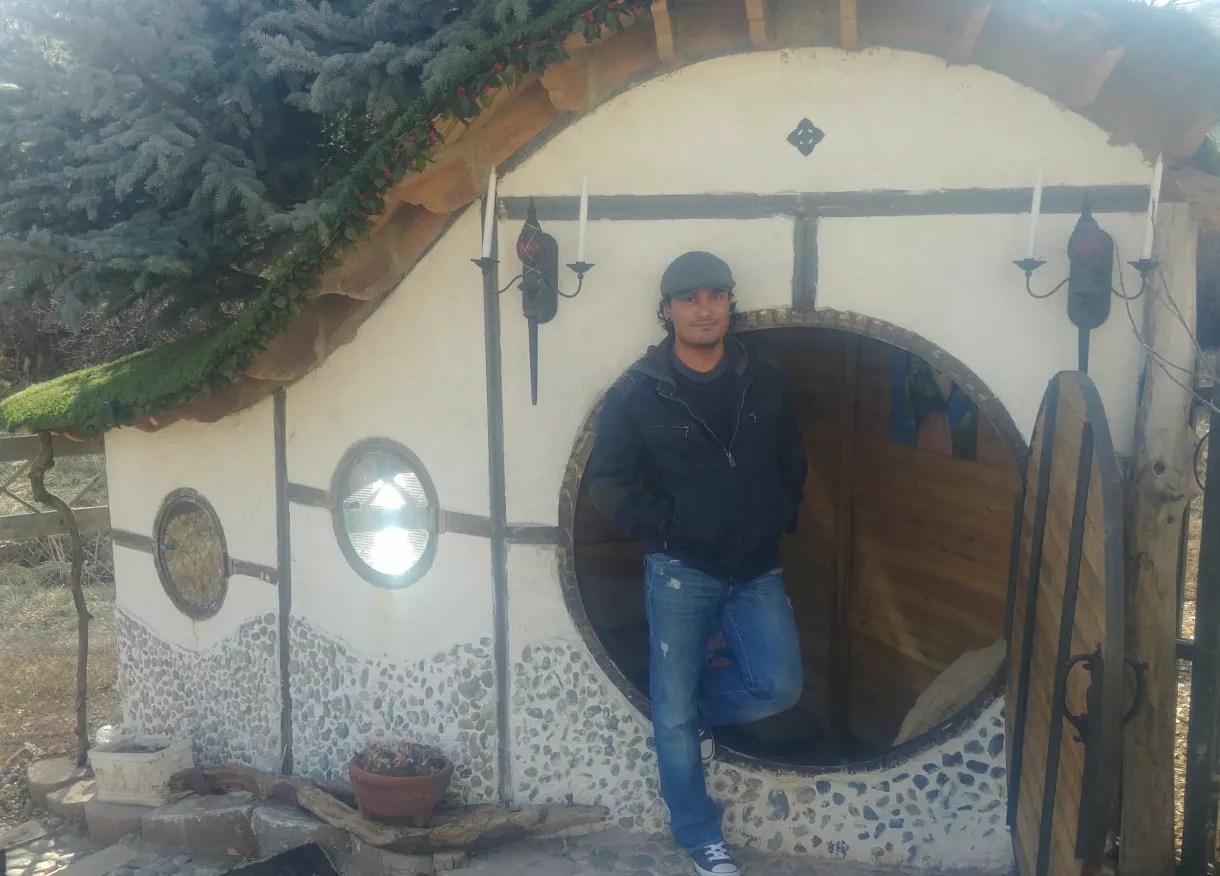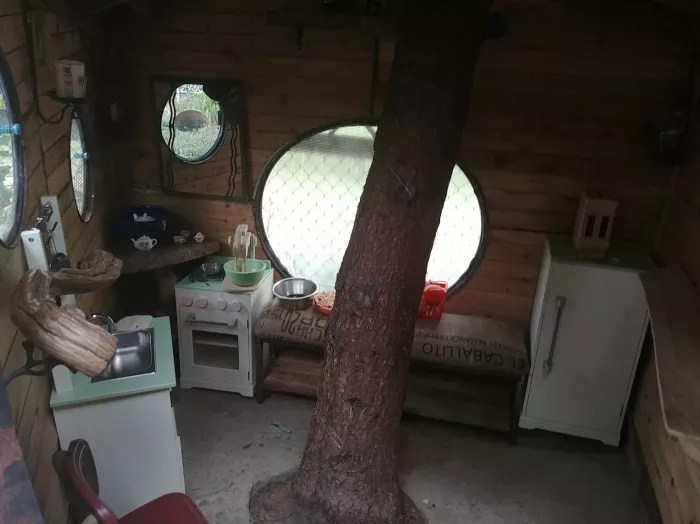
Rudi Monterroso

Audio By Carbonatix
Colorblind from a young age, artist Rudi Monterroso sees beauty and light in everything he crafts, from paintings he produces while flamenco dancing to the elaborate Hobbit playhouses he builds.
“I saw a picture of a Hobbit hole when I was a kid, and I felt a connection because of the shelters and play holes I made as a kid,” Monterroso explains. “When I saw Lord of the Rings and the Hobbit movies, I felt involved with the movie and the Hobbit houses. I loved the use of natural elements and the use of space to incorporate it into nature.”
Monterroso grew up in Guatemala during the country’s civil war, and his childhood home, which was made out of natural elements, was a constant work in progress. Although life was often gloomy, he found solace in maintaining the house.
“I experienced so much brutality, abuse and crime, and it was hard to stay positive,” he recalls. “I grew up in a house that was more than a hundred years old made out of cob – mud and grass. I remember that I would help my grandmother once a month mixing and patching up the holes that animals and erosion made on the wall.”
When news happens, Westword is there —
Your support strengthens our coverage.
We’re aiming to raise $50,000 by December 31, so we can continue covering what matters most to this community. If Westword matters to you, please take action and contribute today, so when news happens, our reporters can be there.
Since his family struggled to put food on the table, buying toys was out of the question – so Monterroso started creating his own.
“I started to make shelters with branches and mud to play with my friends – imagining a beautiful and safe place where no one could get in to hurt us,” he says. “I made toys [and] cars out of carved wood. I would make spaceships, plates and just about any shape with mud and clay. I learned to use what materials were around to create my own imaginary toys and games, to the point that kids that had toys preferred to play with the toys I was making.”
In 1992, at the age of nineteen, Monterroso moved to Boston. There he studied flamenco dancing and enrolled in Bunker Hill Community College, where he changed his major five times before settling on criminal justice. Strapped for cash, he worked a string of low-paying jobs and dug through the trash to find soda cans to trade in for money to buy textbooks. In 1996, he earned his associate’s degree in criminal justice.
“I worked in corrections for two years, and it was frustrating to see so many minorities getting into the system and thinking that that is their life and destiny,” he says. The youth he worked with had been told their whole lives that they were bad people. “I felt that [it] was almost impossible to change that image and help kids.”
Since Monterroso couldn’t help children from within the system, he decided to become an art teacher and give them creative and professional options for the future. He married, with an eye toward building a family. But Massachusetts was becoming too expensive, and his neighborhood was a hotbed of drug dealers. In 2004, he and his wife moved to her home state of Colorado.
Monterroso enrolled in the fine arts program at Metropolitan State University of Denver because it was the most affordable option in town. To make ends meet, he taught art and Spanish to kids at the Auraria Campus Early Learning Center for two years.
Training as an artist, he struggled with being colorblind.
“I always wanted to be a painter, but being colorblind, it seemed almost impossible,” he explains. “My first painting teacher could not understand that I just did not see color. He told me that I should not be painting if I did not see color, and gave me a C-minus at the end of the semester. What he said completely discouraged me. So I switched my concentration and got my major in sculpture, where I did not have to worry about color that much.”
He earned his bachelor’s in fine arts in 2013 and taught art at the nonprofit Downtown Aurora Visual Arts and at William Smith High School, also in Aurora. Then he got a job at the Arts Street youth center because it was closer to his home.
Still, he pursued painting. He tried working in black and white. Then he started using colors, but was frustrated each time he learned through others that they weren’t seeing his works the same way he did. He decided to focus on light as he painted, a skill that took him a few years to develop.
“When I was training my brain to not try to think in color, I started to paint through values from light to dark,” Monterroso explains. “I started with my source of light and how that light affected the object I was painting.”
Soon his career took off. He has exhibited his paintings at the Denver Art Museum, the Chicano Humanities and Arts Council, and the Dairy Arts Center in Boulder, among other spaces. Eventually, after so much painting, Monterroso began suffering from tendonitis.
“I started to modify tools and brushless techniques to make my hand less painful,” he says. “At the same time, I was learning about mindfulness, and I wanted to apply it to my work. But sitting down to meditate did not work for me. The only place I ever felt that peaceful, mindful mind was when I was a flamenco dancer and practiced for hours for my shows.
“I started to combine my dance techniques and paint,” he continues. “I was more aware of my surroundings. I was paying more attention to my interaction with the paint – how the paint reacted to different footwork – even the sound of the stickiness of the paint as I lifted and slid my shoes on the wood canvas. I was mostly trying not to fall, since it gets very slippery. For the first time, I was enjoying not having to focus on the outcome, and I was having so much fun just enjoying the process.”

Monterroso’s Date Night painting.
Rudi Monterroso
Despite all that success, COVID-19 hit Monterroso’s savings hard. He was laid off from his job at Arts Street, and he couldn’t find work for six months. He had twenty art shows slated for the summer, but they were all canceled.
“I finally got a job toward the end of the year doing deliveries for Edible Arrangements, and the pay was minimum wage, making half of the money I was making as a teacher,” Monterroso says. “I have a family of five to support, and art has been an important part of my income. Also, to make art, I have to sell art, and I did not sell any art last year.
“I had always been positive, but this last year really tested my confidence,” he adds. “I decided to give up art and just find a second job so I can make enough to support my family. We had to use all of our savings to not end up on the street.”
He was finally able to secure a teaching job at Littleton’s Cadence Academy Preschool in October 2020, but it still wasn’t enough.
Then life during a pandemic sparked another idea: After seeing so many kids tired of online classes and disconnected from the world and their communities, Monterroso tapped into his childhood love of building and began to make Hobbit houses. He built some for friends and others in public spaces in his neighborhood. Now he’s in the process of turning his Hobbit-house hobby into a business.

The interior of one of Monterroso’s Hobbit playhouses.
Rudi Monterroso
“I sold my car to start to build one and ran out of money,” he says. “But then I was able to sell a painting and finish, so I can start my business. It’s hard to start a business with no money. But I have to try and not sit around waiting for things to get better with the pandemic. If it doesn’t work, at least I can say I tried.”
The cost of the Hobbit houses varies depending on the materials, size and design used. At first Monterroso was using recycled material such as branches, old rustic metal and found wood, but then he decided to buy the materials he needed from antique stores, so each creation is unique.
The starting price for each play set is around $2,000, and each takes about a month to build.
Although times are difficult, Monterroso wants to bring joy to people with his playhouses and other artwork. He hopes that when they learn how he’s overcome economic and physical hardships, they’ll be inspired by his journey.
“Sometimes what we think of [as a] weakness is our uniqueness,” Monterroso says. “If we can embrace our uniqueness, we can find our strengths.”
One of Monterroso’s Hobbit-hole playsets will be available for display at Stanley Marketplace on March 20 from 9 a.m. to 4 p.m. For more information about his work, visit his website.